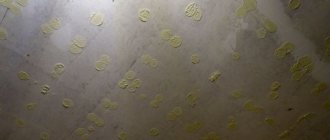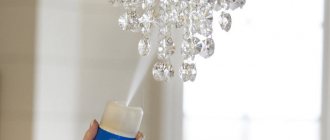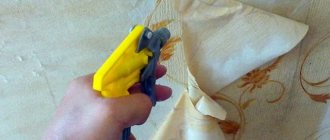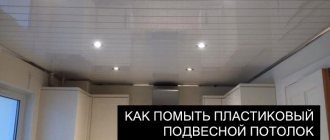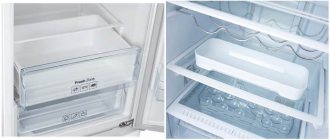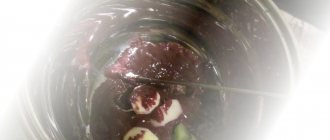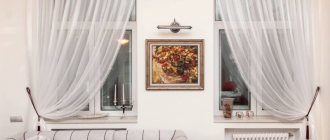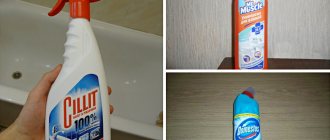Home / Types of ceilings / From ceiling tiles / What and how to wash ceiling tiles?
Any ceiling covering will sooner or later require attention. It will just need to be washed or cleaned. And oddly enough, the care of ceiling tiles raises a lot of questions. As it turns out, not everyone knows how and how to clean it from dirt.
Why do kitchen ceiling tiles get dirty?
Foam ceiling tiles in the kitchen easily become covered with dirt.
The type and quality of the ceiling covering determines its soiling and ability to be cleaned.
Extruded tiles are equipped with a dust-proof and water-repellent layer. Thanks to this, soot and other persistent contaminants do not stick to it. It is more durable and reliable. After deformation it returns to its original form. Cleaning such tiles will not be difficult.
Stamped foam plates have a porous structure. Because of this, they freely absorb kitchen odors, fumes and splashes, which are extremely difficult to wipe off. This type of tile should not be installed in the kitchen. And if this happens, it is necessary to regularly clean it of fresh contaminants so that you do not have to struggle with old grease and soot to no avail.
Injection or seamless ceiling material is not afraid of moisture, so it can be washed with water and detergents. It turns yellow when exposed to direct sunlight.
The most common causes of tile contamination:
- High indoor humidity . Due to moisture, the ceiling covering is attacked by fungus and mold, and stains appear. To avoid this, before gluing the tiles, you need to cover up all the microcracks in the ceiling. Frequent airing and well-functioning ventilation will eliminate excess moisture in the kitchen.
- Insects . Fly dots look extremely unpleasant on the ceiling. The best protection against them is a mosquito net.
- Dust and grease . It is very difficult to avoid these contaminants in the kitchen. Dust flies everywhere, but in the kitchen it becomes greasy and sticky. Therefore, it is more difficult to get rid of it.
- Cigarette smoke . To prevent the foam from becoming saturated with an unpleasant odor, you should not allow anyone to smoke in the kitchen.
Deposits that have accumulated over the years are much more difficult to clean off than fresh dirt. To keep your kitchen ceiling looking fresh, you need to get into the habit of scrubbing it free of dirt once every month or two.
Due to the fact that foam accumulates static electricity, it attracts dust and small debris. Therefore, such tiles get dirty much more often than a regular whitewashed ceiling. And due to the fact that there is a large amount of vapor and grease in the kitchen air, they also settle on the ceiling. At the same time, on a smooth, shiny surface, dirt is especially noticeable.
Under no circumstances should ceiling tiles be washed with solvents.
Do-it-yourself ceiling pasting technologies
The process of decorating a ceiling depends, first of all, on the condition of its surface: flat or curved. In the first case, installation is much faster and does not require additional alignment efforts.
Where you should start installing tiles depends on the type of room and installation method. During the installation process, you should monitor the aesthetic appearance of the coating. The seams between the tiles are sealed with putty or sealant. Excess glue that appears at the joints should be removed with a damp cloth without waiting for complete drying.
On a flat ceiling
Before gluing the tiles, you should check the ceiling surface using a level to make sure there are no differences in height. For concrete and plasterboard ceilings, such a procedure is not required. The method of applying the installation composition depends on the type of glue. Usually the tiles are coated along the perimeter and diagonals. Water-based adhesives, including liquid nails, are applied to the panel in the form of large drops and pressed against the ceiling for even distribution. Then set aside to polymerize for 3-5 minutes and finally installed according to the instructions.
The surfaces of the ceiling and tiles are impregnated with liquid adhesives. The putty is applied to the area under one tile in a thin, even layer. Continue after securing the panel.
If the ceiling is uneven or crooked
It will not be possible to stick high-quality decorative panels onto a curved, cracked surface. It is necessary to seal the cracks or level the ceiling. One of the effective ways to level out large differences is to install ceiling plasterboard. Minor deviations are corrected using putty.
Center of the room
It is most convenient to start installation from the geometric center of the ceiling, which is determined by the intersection of the diagonals. It is taken into account that the chandelier will be located at this point, so the panels are placed around it, cutting the edges for the wires.
Foam Ceiling Tiles Cleaning Tools
You can use a vacuum cleaner to collect surface dirt from the ceiling tiles.
To wash the tiles on the foam ceiling, you need to stock up on a set of equipment suitable for this particular case. For work you will need:
- Vacuum cleaner with a soft fluffy brush . It is used to pre-clean the ceiling of dust and cobwebs.
- , lint-free cloth
- Sponges for washing dishes . If the area of contamination is large, then a lot of them will be needed.
- Highly absorbent dry cloth .
- Paper towels or napkins . They are needed to absorb excess moisture.
- Step ladder.
- A brush with fluffy bristles , for removing yellowness and grease in hard-to-reach places. The special Duster dust brush will become an indispensable assistant in dry cleaning. Its negatively charged soft bristles collect and hold dust.
- Bucket or basin with warm water . Needed for wet cleaning.
- Special sponges for washing dirt from foam. They are impregnated with special compounds and easily remove soot and other impurities from the ceiling.
- Latex gloves.
- Protective glasses . When working with chemicals, it is better to protect your eyes from getting harmful components into them. Moreover, while cleaning you must constantly look up.
- Putty knife . After repairs, when drops of glue or putty get on the tiles, you cannot do without this device. You need to act carefully and carefully so as not to damage the coating.
The sponges must be soft so as not to damage the foam.
A spatula is needed to remove traces of glue and putty
Eyes and hands need to be protected from dust and cleaning agents.
In order to properly wash the ceiling made of foam tiles, you should not rush or use force. Such actions only harm the coating.
An important condition for cleaning the ceiling clean, and not rubbing dirt into it: you need to change the sponges often. They quickly become clogged with soot and instead of cleaning, they smear grease.
Dyeing technology
Before painting, you need to prepare the necessary tools and clean the surface, as well as apply a primer.
Before all work is done, furniture is removed from the room. What cannot be taken out is covered. The floor and other surfaces are covered with plastic film. Places that can be accidentally painted along with foam plastic (the junction of the wall and ceiling or baseboard) are sealed with masking tape.
What you need for painting
List of tools and materials that will be required for work:
- dye;
- primer;
- sealant or putty;
- paint brush, sponge, rubber spatula, roller or spray (depending on the chosen painting method);
- trestles or stepladder;
- container for paint;
- workwear;
- vacuum cleaner, dry brush and detergent to prepare the surface.
Surface preparation
Before painting, the ceiling is cleaned of contaminants (grease deposits, dust), since the paint will not adhere to them. First use a vacuum cleaner. Then, with a dry brush, remove the dust that has accumulated in the unevenness of the relief pattern, since the panels rarely have a smooth surface. After mechanical cleaning, wet cleaning is done. To do this, apply a soap solution using a brush, then wipe dry with a clean napkin or cloth.
If you plan to paint new panels that have just been glued, then you need to fill the seams with sealant. The cracked joints between old tiles are covered with putty to obtain a seamless surface. Use only rubber spatulas so as not to accidentally damage the integrity of the polystyrene foam.
Padding
Prime the ceiling 11-12 hours before painting. The leveling compound is applied with a roller or brush; one layer is sufficient.
Painting work
Painting ceiling tiles at home is possible using a spray gun, brush or roller.
During work, arrange lighting from both sides to avoid uneven coloring and streaks.
Painting is recommended in two layers. The second is applied after the first has dried, making strokes in a perpendicular direction. If it is not possible to achieve the desired layer density, apply the paint a third time.
To obtain a matte ceiling with a glossy relief, the surface is painted with acrylic, then varnish is applied to the protruding parts. This way you can make an original design with your own hands.
The option of applying paint to the slabs before gluing is not very successful. After installation on the ceiling, you will still need to seal the seams and repaint the surface.
Household chemicals for foam tiles
If the foam ceiling is so dirty that it cannot be cleaned using a dry method, resort to wet cleaning. Areas stained with grease and soot are best washed with compounds that can destroy the oily structure of the stain:
- Dishwashing detergents : Myth, Fancy, Fairy, Frosch, Eared nannies, Sorti, Sarma, Surprise for Cinderella, Help, I was born, World of Childhood. In most cases, their aqueous solution can easily wash away most of the stains and soot on the ceiling. This mixture is whipped into a thick foam. Only it is applied to the surface to be treated, not water. At the same time, they do not press and rub with force. The foam mass is only lightly driven in. And if suddenly there is water on the tiles, remove it with paper towels or napkins. Otherwise, gray streaks will appear on the coating.
- Gels for washing clothes without bleach containing: Ushasty Nyan, Laska, Persil, Ariel, Losk, Pemos, Dreft.
- Hair shampoos . The simplest of them, bought in a store, will be suitable for this purpose. To do this, it is diluted with water and whipped until a thick foam is formed, which is used to clean the surface.
Construction and hardware stores also sell special compounds made for cleaning ceilings of various qualities. The sales consultant will tell you what is best to choose for washing a specific type of tile.
Before using any of the listed products, apply its solution to an inconspicuous area of the coating and observe the reaction. Unused pieces of ceiling tiles are also used for this. If no undesirable reaction occurs, then the product is suitable for this type of coating.
Washing powders are not used to clean suspended ceilings. Even a small particle that does not dissolve in water can leave scratches and irrevocably ruin the appearance of the kitchen ceiling.
Painting with water-based emulsion
To work with this group of paints, you will need the devices and tools listed earlier in the article.
The dyeing process consists of the following steps:
- First, paint the joints between the ceiling surface and the walls, moving along the perimeter of the room. For this purpose, take a brush, dip it in the coloring composition, squeeze it lightly and apply it in a strip 3-5 centimeters wide. This is done so that in the future, when using the roller, it does not stain the walls.
- The ceiling is covered with water-based paint in three layers. Use a wide roller. The first layer is applied in the direction of the light flow coming from the windows. Work should begin from the left corner near the wall with the window opening.
- To remove excess paint, roll over the already treated surface with an almost semi-dry roller, almost without paint.
- The second layer is placed perpendicular to the first painting after the starting composition has completely dried on the ceiling. This usually takes 8-12 hours.
- The final layer of paint, after the previous one has dried, begins to be applied from the corner of the wall opposite the window opening. In this case, the roller is moved in the direction of the light coming from the windows. It is better to paint this layer with a new roller and then the surface will be uniform.
Until the painted ceiling has completely dried, experts do not recommend opening doors and windows in the room. It is necessary to ensure that the sun's rays do not fall on the newly repaired coating, so it is better to darken the windows.
Folk remedies for cleaning the ceiling in the kitchen
If you don’t want to use chemicals, then the products used in cooking can help in the fight against pollution just as well. At the same time, they are safe for health:
- Salt . 1 tbsp. l. diluted in 5 liters of water. Soak a sponge in the solution and apply it evenly to the stain. Don't wash it off. The procedure is repeated several times until the other color completely disappears.
- Vinegar . It is mixed with water in a 1:1 ratio. The liquid is used to wash areas that have particularly absorbed kitchen odors. Don't wash it off.
- Acetic acid . In the fight against old stains, use it undiluted. Soak a sponge in the liquid and wipe the problem areas. At the same time, remember about safety precautions. Gloves are put on your hands, glasses and a mask are put on your face. And don’t forget to turn on the hood and open the windows.
- Alcohol . Moisten a clean white rag with it and wipe the stains in a circular motion. The procedure is repeated several times if necessary. Having achieved the desired result, the ceiling is washed with water and dried.
- Eraser . The manufacturers themselves recommend using this stationery to remove fresh stains. Although it is not used in the food industry, the eraser is harmless to human health.
The chemical industry does not produce anything special for cleaning foam tiles. Therefore, homemade products are no worse than those from a hardware store.
Wet the sponge only slightly with the cleaning agent. If the liquid drips down when washing, it means that the ceiling will be covered with wet spots, which will ruin the appearance of the tiles.
How to remove glue residue from the ceiling
Usually, after removing the tiles, 3-4 or even more areas of dried glue remain on the ceiling.
The surface is cleaned with an acetone-based solvent or ordinary nine percent vinegar. Professional products are also suitable, for example, Mellerud, Keranet, Atlas Szop or pharmaceutical dimethyl sulfoxide, which perfectly dissolves the adhesive composition.
To remove the glue you will need:
- Coat dried marks with solvent.
- Use a spatula to clean the “islands” with pieces of tiles.
- If the solvent does not help, use a grinder and a grinder.
After applying chemicals, you must wait a few minutes. The liquid is applied using a sponge, brush or old toothbrush. When the solvent starts working, carefully scrape off the softened mixture with a spatula. Repeat as many times as necessary.
To soften dried glue, use a dishwashing detergent such as Fairy (made by Procter & Gamble), which almost always includes sodium laureth sulfate, polypropylene glycol, and other solvents. 1-2 caps of product per 1.5-2 liters of water is enough. After this, we remove the old glue using a hammer and chisel.
If all else fails, you will have to use a grinder, sandpaper or brush. In this case, a mask and a respirator will come in handy, as there will be a lot of dust. Before starting work, wet the ceiling with water using a spray bottle. It will be much easier to tear off the remaining tiles.
You should not set fire to dried glue, thinking that this will soften it faster. This is dangerous and will not lead to the desired result. Be patient and treat the glue with water or solvent and gradually it will begin to yield. The softened pieces are scraped off with a spatula, and then the surface is cleaned with other means.
What products dissolve glue?
Not only professional products, but also folk recipes will help you remove glue from the ceiling with your own hands.
For example, suitable for dissolving:
- technical alcohol;
- sunflower oil;
- gasoline, turpentine, ammonia;
- a mixture of soda and water;
- hot soapy solution;
- table vinegar.
These products are applied to the remaining glue and wait from a couple of minutes to half an hour. As soon as the substance begins to soften, it is cleaned from the ceiling with a spatula. Sometimes, for faster removal, the treated area is covered with plastic wrap and waited for several hours. Soda paste, oil, vinegar last the longest, but these options are considered one of the most effective.
It is possible to clean the ceiling from glue using the methods described above only if the mixture is not very old. In more complex cases, professional products and serious mechanical cleaning will be required. But if there are only a few problem areas on the surface, then you can really deal with them with water and vinegar or regular oil.
Cleaning steps
You can reach hard-to-reach places with a long-handled brush.
When removing dirt from the ceiling, you should follow a certain sequence. This is necessary so as not to waste time redoing your own mistakes. Here's how to proceed:
- The entire surface of the ceiling is vacuumed to remove dry dust and cobwebs.
- Get into hard-to-reach places with a soft bristle brush and a long handle.
- Dirty stains are wiped off with a strictly dry cloth or sponge.
- Wet cleaning. Using household chemicals or folk remedies, remove greasy stains.
- Wash away foreign odors. Homemade recipes are used for this.
If you arm yourself with the necessary tools, means, and set the goal of cleaning the ceiling, then everything will work out. The difficulty is that your hands quickly get tired of working in this position. Therefore, you will have to rest often.
In extreme cases, when splashes from coffee or ketchup get on the ceiling, or the tiles become covered with rusty stains, such contaminants are removed using whitewash. And stains that are not completely washed are painted over with water-based paint.
Safety precautions
Since you will have to work at heights and with your head up, you need to take care of your own safety.
- To prevent detergents and dust from getting into your eyes, you will need glasses (if you don’t have protective glasses, regular sun glasses will do).
- Rubber gloves will protect the skin of your hands from contact with caustic substances.
- Shoes should have a heel and fit tightly around the foot, and a rubber grooved sole will help prevent falling from a stepladder.
An apron or robe with large pockets will not only keep your clothes clean, but will also allow you to have all the cleaning tools with you, which will significantly speed up the work.
Preventing contamination of foam ceiling tiles in the kitchen
In order not to waste time and energy on washing grease and soot from the ceiling, you need to do dry cleaning in a timely manner.
A coating that is vacuumed once a month stays fresh for a long time. This type of cleaning does not allow greasy dust to accumulate in thick layers. This kind of manipulation is resorted to provided that there are no streaks or stains on the tiles.
And when liquids get on the coating, which can leave an indelible mark, they are removed immediately. Fresh dirt can be easily washed off with a dry cloth or, in extreme cases, with soap foam.
What to do with old stains
Long-term stains cannot be cleaned from the kitchen ceiling using gentle methods. To get rid of them, there are more radical recipes.
| Required substances | Sequencing |
| |
|
|
| |
| |
|
After completing all actions, excess moisture is removed with paper towels.
Tips and tricks for cleaning the ceiling from old glue
To make cleaning as little hassle and inconvenience as possible, you can use some tricks. They will help you avoid some problems:
- To reduce the spread of dust throughout the room, the entire ceiling can be moistened with water. This, of course, will not make it easier to remove the glue, but it will significantly reduce the amount of small debris.
- Spread oilcloth or polyethylene on the floor. At the end of the work, cleaning the room will be much easier.
- If traces of mold are found on the ceiling during renovation, then it is better not to ignore this point. Apply special antifungal compounds to the surface, preferably several times.
- To remove glue from hard-to-reach places (chips, cracks, depressions), use a chisel.
- When performing each stage of work, avoid unnecessary haste. Don't try to remove old glue in one go. It is better to divide the ceiling into several sections and gradually clean each of them.
Placement methods and markings
Installation work begins with marking the ceiling. Regardless of the placement method, determine the diagonal, perpendicular lines, the center of the ceiling. Lines are drawn from opposite corners, the intersection point of which is the center where the lamp will be located. 4 perpendiculars are restored from the center to the edges of the ceiling. The position of the first tile depends on the installation method.
Parallel
Laying begins from the geometric center, around which 4 tiles are placed along perpendicular lines to the walls. The inner corner of each tile must coincide with the geometric center and with each other. Subsequent rows are laid out parallel to perpendicular guides.
Diagonally
When placing the tiles diagonally 4, the central panels meet at the internal corners at the geometric center. The external angles opposite to them lie on perpendiculars, which for the resulting square will be diagonals. Continuation of installation - along the perimeter of the resulting squares with the corners aligned with perpendiculars. The second option for diagonal laying: from the central tile, glued at the corners to perpendiculars along the geometric center / from the chandelier. Subsequent panels are glued along its sides, filling the gaps.
Snake
The sequence of placement from the center of the ceiling along perpendiculars:
First row:
- 1 bottom left tile;
- 2 top left;
- 3 top right;
- 4 bottom right.
Second row:
- 5 lower right;
- 6 lower left;
- 7 lateral lower left;
- 8 bottom left;
- 9 top left;
- 10 upper side left;
- 11 top left;
- 12 top right;
- 13 upper right side…
Continue moving around the perimeter.
With shift
The central row is glued in such a way that one of the perpendiculars “divides” the tiles in half, and the central one is located at their intersection. Subsequent rows on both sides are shifted symmetrically by ½ tile.
Crisscross
The first 4 tiles are glued in the same way when laying parallel to the walls. Subsequent double rows are placed along perpendiculars to the walls, forming a cross.
Diamond
Diamond-shaped gluing starts from the wall. The first tile is laid at an angle to the wall, perpendicular. The second and third tiles are placed to the sides of the panel, the fourth - next to the third. The fifth is glued in between the second and third, the sixth is adjacent to the second, the seventh is adjacent to the sixth. Subsequent rows are filled in order.
Tips for successful painting
The following tips will help you achieve the best results:
- Water-based paint (like acrylic) must be applied in as thin a layer as possible. A thick coating will bubble when applied and peel off as it dries.
- Tiles with a relief pattern are easy to paint with a brush. But if possible, it is better to use a paint spray gun. It will spray the enamel in an even layer and easily paint over all the relief elements. In addition, this method of applying paint takes much less time.
- When painting the ceiling, you do not need to bring the roller to the very edge, so as not to accidentally stain the wall with paint.
- To check the quality of painting, you need to shine a bright lamp on the ceiling. It is better to inspect the coating from different sides, lighting it from different angles.
- Until the paint is completely dry, do not open windows or doors. It is also advisable to protect the surface from heating by sunlight. If the sun shines on the ceiling from a window, it should be curtained.
With this approach, the fresh coating will be smooth and uniform in color. And knowing how to properly paint foam ceiling tiles, you can create a beautiful, stylish and easy-to-clean ceiling in any room with your own hands.
